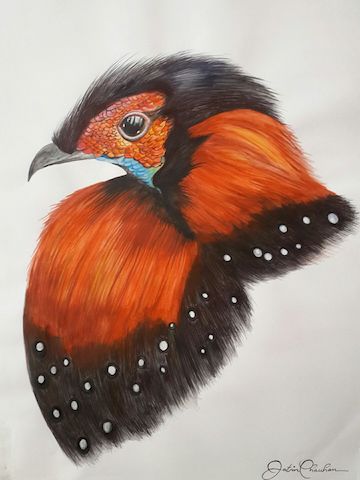Manali: The Nehru aviary here in April-May will display the rare and colourful Western Tragopan, which happens to be the state bird of Himachal Pradesh.
Kullu forest officer for wildlife Tilakraj disclosed that a pair of Western Tragopan pheasant would be soon shifted to the Nehru pheasantry for display purposes from the Sarahan breeding centre.
Found in the Himalayas between the altitudes of 1750 to 3600 meters, the Western Tragopan is a highly endangered pheasant and is on the red list of birds threatened with extinction, disclosed BS Rana, a former director of Great National Himalayan Park (GHNP).
GHNP has been set up mainly to conserve the habitat of Western Tragopan, which is one of the few places in the world where a viable population of the pheasant is found.

The brightly plumed pheasant is also found around the Khyber Pathunakhwa province of Northern Pakistan and in western parts of Uttrakhand.
The male bird is dark with white spots where each spot is bordered with black and deep crimson patches on the sides and back of the neck. The throat is bare with blue skin while the bare facial skin is red. They have a small black occipital crest.
The females have pale brownish-grey upper parts finely vermiculated and spotted with black, and most of the feathers have black patches and central white streaks. The young males resemble females, but are larger with longer legs and a variable amount of black on the head and red on neck.
Their preferred habitat is the dense understorey of temperate, subalpine and broad-leaved forest.
The western tragopan is mostly feeds on leaves, shoots and seeds, but also consume insects and other invertebrates. Like most pheasants, they roost in trees singly or in pairs except during nesting.
During display the males show the throat inflated into lappets that appear purple with pink margins. They also display blue horns with a fancied resemblance to those of the Greek mythological god Pan, whence the name tragopan (tragos “goat” + Pan).
The breeding season is May and June. They build their nests in low tree hollows.
Rana said that the pheasant is very sensitive to anthropogenic disturbance and avoids disturbed habitats, which includes forest habitats where hydro-electric projects are being developed.
In Kullu the bird is locally called jujurana which means “king of birds”. The Western Tragopan was accorded the status of state bird of Himachal Pradesh in 2007.
The world population of the pheasant is estimated at fewer than 5,000 individuals, including the captive ones.

Sanjay Dutta, an engineer by qualification but is a journalist by choice.
He has worked for the premier new agency Press Trust of India and leading English daily Indian Express.
With more than a decade of experience, he has been highlighting issues related to environment, tourism and other aspects affecting mountain ecology.
Sanjay Dutta lives in a village close to Manali in Kullu valley of Himachal.



Lovely and very informative article by Sanjay dutta on western tragopan.